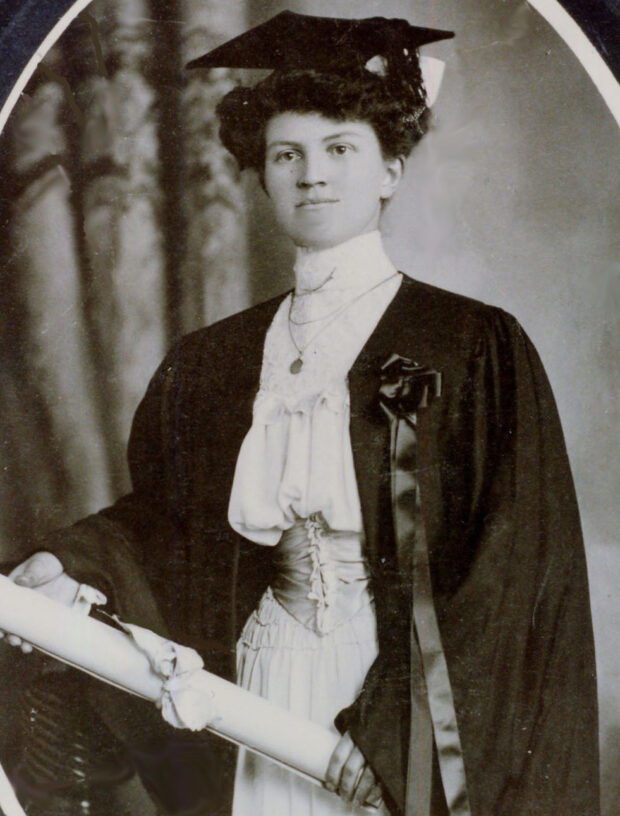Her Patients Loved Dr. Minnie Simmons – 3/16/2024
Written by Chris Rader
As Wenatchee’s first female physician, and the first to specialize in diseases of women and children, Dr. Minnie Simmons attracted a lot of mostly female patients – and they loved her.
“She was a very nice person,” recalled Barbara Carstens Fox, a former neighbor of the Simmons family in South Wenatchee. “She had a busy practice, almost all women. She was the only woman doctor around and women preferred to have her examine them.”
“My mother thought Dr. Minnie was the most wonderful woman in the world,” Ella Bush Dillon said. “Everybody called her Dr. Minnie; it wasn’t till much later that I learned she had a last name!”
Minnie Lee Simmons was born December 25, 1883 in Halfway, Missouri to Harmon and Mattie Simmons. Harmon was originally from West Virginia and acquainted with Confederate General Robert E. Lee, who had been a guest in Harmon’s father’s home. Minnie got her middle name from the general and loved looking at the portrait of Lee that hung in the house.
Minnie was a bright child who started talking at a very early age, according to her mother’s entry in her baby book:
When little Minnie was one year and two months old her Papa left for his old home in West Va. Before leaving he went in to bid her goodbye (it was about 4 a.m.). She sat up in bed and kissed him, saying, “Goodbye, Papa!” just as plain as if she had been grown. We thought that so cute of her we never forgot it.
Packing their goods into a covered wagon, the family headed to Wenatchee in 1886. Mattie noted that Minnie was “a good traveler, always cheerful and interested in everything.” She attracted attention with her big brown eyes and yellow curls, and “made friends with all she met by her sweet shyness and loving obedience.”
Harmon bought a 160-acre homestead a few miles south of town from Billy Smith; the land had frontage on the Columbia River and sloped upward along Squilchuck Creek. Harmon planted alfalfa and a large orchard with walnuts, peaches, apricots, cherries and apples. Historian L.M. Hull credits him with planting the first Moorpark apricots in the Wenatchee Valley. The family lived in a large two-story house on Boodry Street, west of the road that ran from Wenatchee to Malaga. It had a root cellar built into the hill, Barbara Fox recalled, and there was a large pasture for the family horses.
Minnie’s little sister Mabel (nicknamed Babe) was born in April 1890. Though Minnie was more than six years older she was devoted to Babe, and within a few years the girls were playing together: riding their horses, gathering eggs from the family hens, running through the orchard and exploring the nearby sagebrush-covered hills. The entire Simmons family was admired and beloved by their South Wenatchee neighbors, according to many sources interviewed for this article.
In 1920 Harmon sold about six acres of his land to the newly formed Wenatchee Automotive Dealers Association for use as an auto park for tourists. The property was covered with shade trees and shrubs and had several springs of cold, pure water. After two years as a park, this parcel and other Simmons land was sold to the Great Northern Railway Company when the company moved its Cascade Division headquarters from Leavenworth to the new terminal called Appleyard.
The community of South Wenatchee grew up around Appleyard in the ‘20s. Most of the new residents were railroad men and their families; many were Japanese who coexisted in harmony with the Caucasians. There were two hotels, two cafés, a post office and Frank Yama’s grocery store, another grocery store with a gas station, John Smith’s butcher shop, Mr. Barta’s shoe repair shop, Mr. Carstens’ barber shop, a church on Beuzer Street, and at least one saloon reputed to house “ladies of the night.” By 1924 children attended the new South Wenatchee School on Terminal Street, at the location of today’s Mission View Elementary.
Medical school and marriage
But when Minnie and Babe were children they went to the Stevens School at Yakima and Okanogan streets. Though Wenatchee had no high school at the time, Babe later told a newspaper reporter that Minnie graduated in a class of four. Minnie enrolled at Vashon College in 1900 and obtained a two-year pharmacy degree. She then moved to St. Louis and began studies at Barnes Medical College where she was one of only four women among 60 men. A few days after graduating with a medical degree in 1905 she was married by a Justice of the Peace to fellow Barnes student Alex Seibert. The two completed a residency at Barnes and then opened a combined practice in Desloge, Missouri, where Minnie treated women and children and delivered many babies.
Minnie was homesick for Wenatchee, though, and persuaded Alex to try and pass the Washington state medical boards in Tacoma in 1911. The two were among about 20 who passed the grueling exam, out of 83 applicants. They moved to Wenatchee and set about establishing a joint medical practice in a small second-floor office in the Griggs Building on Wenatchee Avenue (near today’s Pak-It-Rite).
By 1915 they had moved to a larger office in the Commercial Bank Building on the southeast corner of Palouse and Wenatchee Avenue. Two articles in The Wenatchee Daily World praised Drs. Seibert and Seibert as “Wenatchee boosters” who see a “bright future for Apple City.” One article noted that Dr. Alex Seibert was devoting himself to general medical practice and specializing in X-ray work, while his wife specialized in diseases of women and children. The article called the medical office “strictly modern in equipment throughout”:
Dr. A.W. Seibert has one of the largest and latest improved X-ray plants in the Pacific Northwest. His laboratory is complete in every detail, with its special appliances and dark room and its facilities for making life-sized X-ray prints. Dr. Minnie Seibert’s consulting and operating room is equally modern in equipment. Their medical library contains the latest accepted works on pathology and related subjects. The atmosphere itself breathes up to dateness.
The article assured readers that the Seiberts were, of course, members of the county and state medical associations and the American Medical Association. It ended with the rosy observation that “It is scarcely necessary to add that the Seiberts are popular socially.”
Another Daily World article on June 14, 1915 took the praise one step further, asserting that Drs. Seibert and Seibert had installed “the largest, most powerful and most elaborate X-ray machine west of Chicago with the exception of one in San Francisco which is identical.” It went on to predict, “The installation of this machine is only one step in the evolution of Wenatchee into a surgical and medical center. The opening of the big new hospital (Deaconess) with its exceptional equipment, on the 28th of this month, is another step in this direction.”
Alex Seibert was listed as the city health officer in the 1914-15 Polk Directory. He and Minnie purchased a building lot near the railroad tracks from Taz and Patsy Rarey in 1914; Minnie’s sister Babe signed the warranty deed as deputy Chelan County auditor. The couple had marital problems, though. Alex relinquished the property to Minnie in November 1917 for one dollar and left town. He enlisted in the U.S. Army and fought in France during World War I. Minnie checked herself into the Eastern Washington State Hospital, a mental institution, presumably for depression; she stayed several months, returning in January 1918 and moving into her parents’ home in South Wenatchee.
The Seiberts’ divorce was finalized on June 17, 1919. Returning to her maiden name, Dr. Minnie Simmons devoted herself to her medical practice – working from her downtown office and making house calls, especially in South Wenatchee. Several sources referred to her as South Wenatchee’s doctor. Minnie was one of the Wenatchee doctors who treated patients during the Spanish flu epidemic of 1918, and after the devastating flood of 1925. This catastrophe occurred right in her own back yard and left lasting effects on the South Wenatchee neighborhood.
Dr. Minnie tends neighbors
A cloudburst high above the Wenatchee Mountains on Sept. 5 of that year caused a 15-foot wall of water to roar down Squilchuck Creek to the Appleyard railroad terminal. The flash flood picked up tree stumps and one-ton boulders, turning the creek into a raging river that would become temporarily dammed and then overflow with great force. The floodwaters even lifted the Springwater Hotel off its foundation and smashed it into the New Terminal Hotel. Four children were immediately swept away to their death. A total of 16 people died, eight of them children, and at least a dozen were injured during a freak event that lasted less than a half hour. The Simmons house was not damaged, but the family felt the pain of their neighbors’ losses. “Dr. Minnie,” as she was called, worked tirelessly through the disaster, tending to the injured and even giving a room in the Simmons home to an injured child, 13-year-old Martha Ernst.
Dr. Minnie Simmons made house calls and tended to many of her South Wenatchee neighbors in her own home office. (She also maintained an office in downtown Wenatchee.) One woman who grew up near the Simmons home remembers being treated by her at about age 12. “There was some kind of itch going around,” she said. “My brother had it and Mother sent us down there. Dr. Minnie gave us some kind of papers that had some kind of substance to rub on the itch. It had a sulphur smell.” The doctor also treated this woman’s father for a concussion suffered in a logging truck accident.
Jackie Smart, who was living in East Wenatchee as a child, said her mother took her to see Dr. Minnie Simmons when she was four years old. She had German measles and went into convulsions. “I had a fever of 107. Dr. Simmons told mother to put me in a tub of cold water to bring the fever down. It worked! Then she told Mother to take me to Children’s Hospital (in Seattle) for treatment. I became paralyzed on my left side, for the rest of my life, but survived thanks to Dr. Simmons.”
Ella Bush Dillon probably has the earliest memories of Dr. Minnie of all living Wenatcheeites. “I cried at her when she delivered me on February 20, 1933,” Dillon said.
I was born at my grandmother’s house in South Wenatchee. There was no electricity, so Aunt Ethel was holding a kerosene lantern. During the birth, Dr. Minnie asked Grandmother for some rags for cleaning up the mess. Grandmother was very proud of her laundry. She brought out a beautiful, newly washed pair of sheets and gave them to her. Dr. Minnie tore them up. They almost got into a fight! My mother’s lying there, trying to deliver a baby. Aunt Ethel, holding the lantern, started to feel queasy at the sight of her sister’s labor and said to my dad, “Take the lamp, I’m going to faint!” Dad called the doctor over to help Aunt Ethel. “I’m busy!” Dr. Minnie said. It was quite the circus.
Dillon remarked that this incident shows that, friendly and sweet as she was, Dr. Minnie was “all business” while taking care of a patient.
Dr. Minnie also delivered Fred Baugh, one of Fred and Luella Baugh’s seven children growing up in South Wenatchee. She took out young Fred’s tonsils when he was 12. “I went to the (Deaconess) hospital for the operation and had ether,” Fred recalled. “I was sick and vomiting and woke up with a sore throat. I was promised ice cream which was quite a treat for us. It was the Depression time.”
Fred’s older sister, Irma Baugh Wise, remembers Dr. Minnie – the family’s doctor from the time Irma was two. “My brothers were always having accidents,” she laughed. “Dr. Minnie always came to the house to take care of them. She was a very faithful doctor; very friendly and very willing to take care of people. She was a sweet, patient person.”
Dr. Minnie removed the tonsils from three more of the Baugh children in one day; Irma was eight, Odin was 10 and Norbert was 12. Irma Baugh writes of a time the family called Dr. Minnie one evening when Leslie, the second-oldest boy, was badly burned. Against his dad’s advice, he had been putting gas in the family’s old Model T Ford by the light of a kerosene lantern.
Just a short time later, Dad caught a glimpse of something bright flash by the window.… He jumped up and ran out the front door scooping up a scatter rug from in front of the door as he ran. He intercepted a flaming Les, threw him to the ground and rolled him in the rug. Mother was lying across the bed nursing Norman when Dad brought Leslie in. His shirt had only small burned hole, but his arm was blistered from his shoulder to his wrist. Dr. Minnie Simmons was called and she came right to the house. She dressed the arm and showed Mother how to take care of it. That was a hard job for Mother to do every day because of the terrible odor the burned flesh gave off.
Dr. Minnie also came to the Baugh home to care for the father, who was a signal maintainer for the railroad. He had a bad case of pneumonia. Dr. Minnie mentioned to Irma’s mother, Luella, that she wished she had some whiskey to give him – but it was during Prohibition. The family lived two doors away from the New Terminal Hotel. Later that evening hotel owner Joe Beuzer knocked at the door with a bottle of Canadian whiskey. “I don’t know how he heard that we were looking for some whiskey,” Irma mused. “People helped each other a great deal during the Depression days.”
Dr. Minnie treated an elderly woman in the early 1940s when she was suffering from dementia; her cognitive functions were limited and she was no longer speaking. “The last time Dr. Minnie came up, Grandma was really gone,” the woman’s granddaughter recently said. “Dr. Minnie said she could give her a shot of morphine and that would be it. Mother said yes, that would probably be a good thing. On her death certificate it said she (Grandma) died of old age. In those days maybe that happened quite a bit; who knows?”
Son Preston is born
Dr. Minnie Simmons had been divorced from Dr. Alex Simmons for two years when she became pregnant. No father’s name is listed on the birth certificate of her son, Preston Herman Simmons, born at home on August 3, 1922. (The middle name was supposed to be Harmon, but was misspelled; the family never had it corrected.) They lived with her parents. Minnie was devoted to her son, and he to her; he wrote flowery letters that began, “My dearest mother…” Preston left for the University of Washington in 1939. In Seattle he met Erna von Marbod, whom he married in 1941. He enlisted in the U.S. Army and served as a tank commander during World War II, fighting in the Battle of the Bulge and receiving a Purple Heart.
Preston was on his way back from Europe on leave, intending to surprise his mother, when tragedy struck. On October 14, 1945, Minnie and her friend Sadie Meyer were driving over Stevens Pass on U.S. Highway 2 en route to visit Minnie’s widowed mother, Mattie, who was living in Marysville. A road crew was resurfacing the highway a few miles west of the summit. Minnie was evidently driving too fast, unable to stop at the flagman’s frantic warning. Her car crashed into a dump truck. Minnie was killed instantly and Sadie died a half hour later.
The community was devastated at the loss of its only woman physician. Dr. Minnie’s priest from St. Joseph’s Catholic Church, the Rev. Father Eugene Duffy, said Holy Rosary and conducted Mass and Dr. Minnie was buried in the Wenatchee cemetery on Western Avenue. Seventy-six people or organizations sent flowers, including the student body and sisters of St. Anthony’s Hospital. In a sympathy letter to Preston Simmons, one woman wrote: “There are ever so many people who do not know you and those who do who will not let you know how much they share in your grief. Your mother will be remembered best for the unselfishness with which she worked professionally…”
Preston continued his Army career, retiring as a colonel. He returned to the Puget Sound area and opened insurance offices in Everett and Wenatchee. He was an avid outdoorsman and active with Rotary International, the Elks Club and Boy Scouts. He and Erna had three children: Tanya, Cheri and Preston Mark Simmons. Erna died in 1981; two years later Preston married Margett Launderville. Preston Herman Simmons died in 2003.
SOURCES:
Odin Baugh, A Place Called South Wenatchee, 1992.
John A. Gellatly, A History of Wenatchee, 1963.
L.M. Hull, A History of Central Washington, 1929.
Letter to Preston Simmons from Estella Kyne, Oct. 19, 1945.
The Wenatchee Daily World: June 14, 1915; undated; Oct. 18, 1945; Oct. 10, 1971.
Irma Baugh Wise, Reminiscing, family memories and photos, 1998.
Interviews with:
Fred Baugh
Ella Bush Dillon
Barbara Carstens Fox
Jill (Mrs. Preston M.) Simmons
Jackie Smart
Irma Baugh Wise
This story was originally published in Confluence Magazine in the Spring edition of 2012. In an effort to preserve these stories, the Wenatchee Valley Museum and Cultural Center will be posting these stories on the museum’s official blog.
Become a member to get a free copy of Confluence Magazine. Learn more about how to become a member here!



